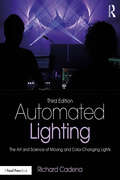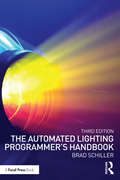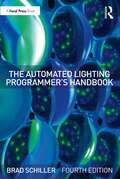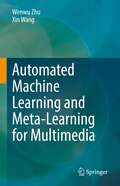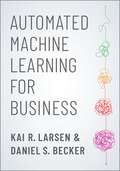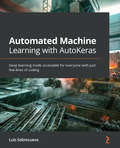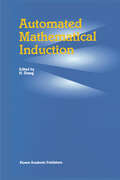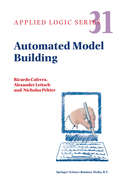- Table View
- List View
Automated Lighting: The Art and Science of Moving and Color-Changing Lights
by Richard CadenaAutomated Lighting: The Art and Science of Moving and Color-Changing Lights, Third Edition (formerly Automated Lighting: The Art and Science of Moving Light) continues to be the most trusted text for working and aspiring lighting professionals. Now in its third edition, it has been fully updated to reflect the vast changes in stage and studio luminairies—including LEDs, switch-mode power supplies, optics, networking, Ethernet-based protocols like Art-Net and sACN, wireless DMX, and much more. Its written in clear, easy-to-understand language and includes enough detailed information to benefit for the most experienced technicians, programmers, and designers. Additional content and resources are provided at the author's website www.automatedlighting.pro.
The Automated Lighting Programmer's Handbook
by Brad SchillerThis guide helps lighting designers with the creative and operational challenges they face in their rapidly evolving industry. Providing respected and clear coverage of the process of programming automated lighting fixtures, the author brings the designer from basic principles to preproduction preparations. Concepts, procedures, and guidelines to ensure a successful production are covered as well as troubleshooting, much needed information on work relationships, and technology including LED lighting, console networking, digital lighting, and more. Chapters are peppered with advice and war stories from some of the most prominent lighting designers of today.
The Automated Lighting Programmer's Handbook
by Brad SchillerThis guide helps lighting designers with the creative and operational challenges they face in their rapidly evolving industry. Providing respected and clear coverage of the process of programming automated lighting fixtures, the author brings the designer from basic principles to preproduction preparations. Concepts, procedures, and guidelines to ensure a successful production are covered as well as troubleshooting, much needed information on work relationships, and technology including LED lighting, console networking, digital lighting, and more. Chapters are peppered with advice and war stories from some of the most prominent lighting designers of today.
The Automated Lighting Programmer's Handbook
by Brad SchillerThe Automated Lighting Programmer’s Handbook, fourth edition, provides respected and clear coverage of the process of programming automated lighting fixtures from basic principles to advanced production preparations. This guide helps lighting programmers and designers with the creative and operational challenges they face in their rapidly evolving industry. Concepts, procedures, and guidelines to ensure a successful production are covered as well as troubleshooting, much needed information on workflows, technology, work relationships, console networking, digital lighting, and more. Chapters are peppered with advice and war stories from some of the most prominent lighting designers and programmers of today. The fourth edition is the most comprehensive yet: added topics include programming structure, advanced recording/editing, cloning, multi-cell fixtures, safety routines, GDTF, and pre-visualization. Deep explorations into the work of programmers from Earlybird and Broadway provide readers with timely real-world scenarios and advice. The information in this book is perfect for anyone interested in the programming of automated lighting in any market. From the beginner to the expert, the methodologies within provide simple, yet powerful tools to assist with any production. Lighting designers also will gain important knowledge about the procedures and concepts utilized by lighting programmers.
The Automated Lighting Programmer's Handbook
by Brad SchillerThe Automated Lighting Programmer’s Handbook, fourth edition, provides respected and clear coverage of the process of programming automated lighting fixtures from basic principles to advanced production preparations. This guide helps lighting programmers and designers with the creative and operational challenges they face in their rapidly evolving industry. Concepts, procedures, and guidelines to ensure a successful production are covered as well as troubleshooting, much needed information on workflows, technology, work relationships, console networking, digital lighting, and more. Chapters are peppered with advice and war stories from some of the most prominent lighting designers and programmers of today. The fourth edition is the most comprehensive yet: added topics include programming structure, advanced recording/editing, cloning, multi-cell fixtures, safety routines, GDTF, and pre-visualization. Deep explorations into the work of programmers from Earlybird and Broadway provide readers with timely real-world scenarios and advice. The information in this book is perfect for anyone interested in the programming of automated lighting in any market. From the beginner to the expert, the methodologies within provide simple, yet powerful tools to assist with any production. Lighting designers also will gain important knowledge about the procedures and concepts utilized by lighting programmers.
Automated Low-Altitude Air Delivery: Towards Autonomous Cargo Transportation with Drones (Research Topics in Aerospace)
by Johann C. DauerThis book investigates Unmanned Aircraft Systems (UAS) with a payload capacity of one metric ton for transportation. The authors provide a large variety of perspectives–from economics to technical realization. With the focus on such heavy-lift cargo UAS, the authors consider recently established methods for approval and certification, which they expect to be disruptive for unmanned aviation. In particular, the Specific Operations Risk Assessment (SORA) and its impact on the presented technological solutions and operational concepts are studied. Starting with the assumption of an operation over sparsely populated areas and below common air traffic, diverse measures to further reduce operational risks are proposed. Operational concepts derived from logistics use-cases set the context for an in-depth analysis including aircraft and system design, safe autonomy as well as airspace integration and datalinks. Results from simulations and technology demonstrations are presented as a proof of concept for solutions proposed in this book.
Automated Machine Learning: Methods, Systems, Challenges (The Springer Series on Challenges in Machine Learning)
by Lars Kotthoff Joaquin Vanschoren Frank HutterThis open access book presents the first comprehensive overview of general methods in Automated Machine Learning (AutoML), collects descriptions of existing systems based on these methods, and discusses the first series of international challenges of AutoML systems. The recent success of commercial ML applications and the rapid growth of the field has created a high demand for off-the-shelf ML methods that can be used easily and without expert knowledge. However, many of the recent machine learning successes crucially rely on human experts, who manually select appropriate ML architectures (deep learning architectures or more traditional ML workflows) and their hyperparameters. To overcome this problem, the field of AutoML targets a progressive automation of machine learning, based on principles from optimization and machine learning itself. This book serves as a point of entry into this quickly-developing field for researchers and advanced students alike, as well as providing a reference for practitioners aiming to use AutoML in their work.
Automated Machine Learning: Hyperparameter optimization, neural architecture search, and algorithm selection with cloud platforms
by Adnan Masood Ahmed SherifGet to grips with automated machine learning and adopt a hands-on approach to AutoML implementation and associated methodologiesKey FeaturesGet up to speed with AutoML using OSS, Azure, AWS, GCP, or any platform of your choiceEliminate mundane tasks in data engineering and reduce human errors in machine learning modelsFind out how you can make machine learning accessible for all users to promote decentralized processesBook DescriptionEvery machine learning engineer deals with systems that have hyperparameters, and the most basic task in automated machine learning (AutoML) is to automatically set these hyperparameters to optimize performance. The latest deep neural networks have a wide range of hyperparameters for their architecture, regularization, and optimization, which can be customized effectively to save time and effort. This book reviews the underlying techniques of automated feature engineering, model and hyperparameter tuning, gradient-based approaches, and much more. You'll discover different ways of implementing these techniques in open source tools and then learn to use enterprise tools for implementing AutoML in three major cloud service providers: Microsoft Azure, Amazon Web Services (AWS), and Google Cloud Platform. As you progress, you'll explore the features of cloud AutoML platforms by building machine learning models using AutoML. The book will also show you how to develop accurate models by automating time-consuming and repetitive tasks in the machine learning development lifecycle. By the end of this machine learning book, you'll be able to build and deploy AutoML models that are not only accurate, but also increase productivity, allow interoperability, and minimize feature engineering tasks.What you will learnExplore AutoML fundamentals, underlying methods, and techniquesAssess AutoML aspects such as algorithm selection, auto featurization, and hyperparameter tuning in an applied scenarioFind out the difference between cloud and operations support systems (OSS)Implement AutoML in enterprise cloud to deploy ML models and pipelinesBuild explainable AutoML pipelines with transparencyUnderstand automated feature engineering and time series forecastingAutomate data science modeling tasks to implement ML solutions easily and focus on more complex problemsWho this book is forCitizen data scientists, machine learning developers, artificial intelligence enthusiasts, or anyone looking to automatically build machine learning models using the features offered by open source tools, Microsoft Azure Machine Learning, AWS, and Google Cloud Platform will find this book useful. Beginner-level knowledge of building ML models is required to get the best out of this book. Prior experience in using Enterprise cloud is beneficial.
Automated Machine Learning and Meta-Learning for Multimedia
by Wenwu Zhu Xin WangThis book disseminates and promotes the recent research progress and frontier development on AutoML and meta-learning as well as their applications on computer vision, natural language processing, multimedia and data mining related fields. These are exciting and fast-growing research directions in the general field of machine learning. The authors advocate novel, high-quality research findings, and innovative solutions to the challenging problems in AutoML and meta-learning. This topic is at the core of the scope of artificial intelligence, and is attractive to audience from both academia and industry.This book is highly accessible to the whole machine learning community, including: researchers, students and practitioners who are interested in AutoML, meta-learning, and their applications in multimedia, computer vision, natural language processing and data mining related tasks. The book is self-contained and designed for introductory and intermediate audiences. No special prerequisite knowledge is required to read this book.
Automated Machine Learning for Business
by Kai R. Larsen Daniel S. BeckerTeaches the machine learning process for business students and professionals using automated machine learning, a new development in data science that requires only a few weeks to learn instead of years of training Though the concept of computers learning to solve a problem may still conjure thoughts of futuristic artificial intelligence, the reality is that machine learning algorithms now exist within most major software, including Websites and even word processors. These algorithms are transforming society in the most radical way since the Industrial Revolution, primarily through automating tasks such as deciding which users to advertise to, which machines are likely to break down, and which stock to buy and sell. While this work no longer always requires advanced technical expertise, it is crucial that practitioners and students alike understand the world of machine learning. In this book, Kai R. Larsen and Daniel S. Becker teach the machine learning process using a new development in data science: automated machine learning (AutoML). AutoML, when implemented properly, makes machine learning accessible by removing the need for years of experience in the most arcane aspects of data science, such as math, statistics, and computer science. Larsen and Becker demonstrate how anyone trained in the use of AutoML can use it to test their ideas and support the quality of those ideas during presentations to management and stakeholder groups. Because the requisite investment is a few weeks rather than a few years of training, these tools will likely become a core component of undergraduate and graduate programs alike. With first-hand examples from the industry-leading DataRobot platform, Automated Machine Learning for Business provides a clear overview of the process and engages with essential tools for the future of data science.
Automated Machine Learning for Business
by Kai R. Larsen Daniel S. BeckerTeaches the machine learning process for business students and professionals using automated machine learning, a new development in data science that requires only a few weeks to learn instead of years of training Though the concept of computers learning to solve a problem may still conjure thoughts of futuristic artificial intelligence, the reality is that machine learning algorithms now exist within most major software, including Websites and even word processors. These algorithms are transforming society in the most radical way since the Industrial Revolution, primarily through automating tasks such as deciding which users to advertise to, which machines are likely to break down, and which stock to buy and sell. While this work no longer always requires advanced technical expertise, it is crucial that practitioners and students alike understand the world of machine learning. In this book, Kai R. Larsen and Daniel S. Becker teach the machine learning process using a new development in data science: automated machine learning (AutoML). AutoML, when implemented properly, makes machine learning accessible by removing the need for years of experience in the most arcane aspects of data science, such as math, statistics, and computer science. Larsen and Becker demonstrate how anyone trained in the use of AutoML can use it to test their ideas and support the quality of those ideas during presentations to management and stakeholder groups. Because the requisite investment is a few weeks rather than a few years of training, these tools will likely become a core component of undergraduate and graduate programs alike. With first-hand examples from the industry-leading DataRobot platform, Automated Machine Learning for Business provides a clear overview of the process and engages with essential tools for the future of data science.
Automated Machine Learning on AWS: Fast-track the development of your production-ready machine learning applications the AWS way
by Trenton Potgieter Jonathan DahlbergAutomate the process of building, training, and deploying machine learning applications to production with AWS solutions such as SageMaker Autopilot, AutoGluon, Step Functions, Amazon Managed Workflows for Apache Airflow, and moreKey FeaturesExplore the various AWS services that make automated machine learning easierRecognize the role of DevOps and MLOps methodologies in pipeline automationGet acquainted with additional AWS services such as Step Functions, MWAA, and more to overcome automation challengesBook DescriptionAWS provides a wide range of solutions to help automate a machine learning workflow with just a few lines of code. With this practical book, you'll learn how to automate a machine learning pipeline using the various AWS services. Automated Machine Learning on AWS begins with a quick overview of what the machine learning pipeline/process looks like and highlights the typical challenges that you may face when building a pipeline. Throughout the book, you'll become well versed with various AWS solutions such as Amazon SageMaker Autopilot, AutoGluon, and AWS Step Functions to automate an end-to-end ML process with the help of hands-on examples. The book will show you how to build, monitor, and execute a CI/CD pipeline for the ML process and how the various CI/CD services within AWS can be applied to a use case with the Cloud Development Kit (CDK). You'll understand what a data-centric ML process is by working with the Amazon Managed Services for Apache Airflow and then build a managed Airflow environment. You'll also cover the key success criteria for an MLSDLC implementation and the process of creating a self-mutating CI/CD pipeline using AWS CDK from the perspective of the platform engineering team. By the end of this AWS book, you'll be able to effectively automate a complete machine learning pipeline and deploy it to production.What you will learnEmploy SageMaker Autopilot and Amazon SageMaker SDK to automate the machine learning processUnderstand how to use AutoGluon to automate complicated model building tasksUse the AWS CDK to codify the machine learning processCreate, deploy, and rebuild a CI/CD pipeline on AWSBuild an ML workflow using AWS Step Functions and the Data Science SDKLeverage the Amazon SageMaker Feature Store to automate the machine learning software development life cycle (MLSDLC)Discover how to use Amazon MWAA for a data-centric ML processWho this book is forThis book is for the novice as well as experienced machine learning practitioners looking to automate the process of building, training, and deploying machine learning-based solutions into production, using both purpose-built and other AWS services. A basic understanding of the end-to-end machine learning process and concepts, Python programming, and AWS is necessary to make the most out of this book.
Automated Machine Learning With Autokeras: Deep Learning Made Accessible For Everyone With Just Few Lines Of Coding
by Luis SobrecuevaDeep learning made accessible for everyone with just few lines of coding
Automated Machine Learning with Microsoft Azure: Build Highly Accurate And Scalable End-to-end Ai Solutions With Azure Automl
by Dennis Michael SawyersBuild highly accurate and scalable end-to-end AI solutions with Azure AutoML
Automated Market Makers: A Practical Guide to Decentralized Exchanges and Cryptocurrency Trading
by Miguel Ottina Peter Johannes Steffensen Jesper KristensenExplore Automated Market Makers (AMMs), the underlying protocols used by decentralized exchanges (DEX) to allow users to perform trades of cryptocurrencies in a decentralized way with no middlemen. This book provides a thorough study and a clear-cut exposition of the principal AMMs (Uniswap v2 and v3, Balancer, and Curve).You'll receive a detailed description of how these AMMs work, unveiling the mathematics behind them and showing plenty of examples as well as novel proofs for several interesting facts. Each chapter describes an AMM's core idea and derives the mathematical formulas used in the code, giving careful explanations of the logical thinking involved and detailing the steps needed to reach those formulas. All these explanations are complemented with thoughtfully chosen examples which further help to enlighten the readers on how the formulae work. In addition, the relevant parts of the codes of the AMMs are shown after explaining each formula so that the actual implementation of the formulae can be seen.In a traditional trading market a buy order has to be matched with a sell order to achieve a trade. However, for an AMM, users trade against the protocol itself, a smart contract, or a community pool of funds. In simple terms this is an open source computer program in which mathematical formulas define prices. Automated Market Makers examines this critical point revealing that no banks or intermediaries are necessary, giving crucial financial access to a much larger crowd, regardless of who they are with less barriers to access.What You'll LearnUnderstand the principals of decentralized finance (DeFi)Grasp mathematical formulae that underpin decentralized exchangesWork with Solidity programming languageReview current industry best practices Who This Book Is ForThose new to Blockchain and Cryptocurrency trading, who want to learn more about AMMsDevelopers who want to dive deeper into the core features of AMM platformsInvestors and venture capitalists who want to know more about new emerging technologies
Automated Mathematical Induction
by Hantao Hantao ZhangIt has been shown how the common structure that defines a family of proofs can be expressed as a proof plan [5]. This common structure can be exploited in the search for particular proofs. A proof plan has two complementary components: a proof method and a proof tactic. By prescribing the structure of a proof at the level of primitive inferences, a tactic [11] provides the guarantee part of the proof. In contrast, a method provides a more declarative explanation of the proof by means of preconditions. Each method has associated effects. The execution of the effects simulates the application of the corresponding tactic. Theorem proving in the proof planning framework is a two-phase process: 1. Tactic construction is by a process of method composition: Given a goal, an applicable method is selected. The applicability of a method is determined by evaluating the method's preconditions. The method effects are then used to calculate subgoals. This process is applied recursively until no more subgoals remain. Because of the one-to-one correspondence between methods and tactics, the output from this process is a composite tactic tailored to the given goal. 2. Tactic execution generates a proof in the object-level logic. Note that no search is involved in the execution of the tactic. All the search is taken care of during the planning process. The real benefits of having separate planning and execution phases become appar ent when a proof attempt fails.
Automated Media
by Mark AndrejevicIn this era of pervasive automation, Mark Andrejevic provides an original framework for tracing the logical trajectory of automated media and their social, political, and cultural consequences. This book explores the cascading logic of automation, which develops from the information collection process through to data processing and, finally, automated decision making. It argues that pervasive digital monitoring combines with algorithmic decision making and machine learning to create new forms of power and control that pose challenges to democratic forms of accountability and individual autonomy alike. Andrejevic provides an overview of the implications of these developments for the fate of human experience, describing the "bias of automation" through the logics of pre-emption, operationalism, and "framelessness." Automated Media is a fascinating and groundbreaking new volume: a must-read for students and researchers of critical media studies interested in the intersections of media, technology, and the digital economy.
Automated Media
by Mark AndrejevicIn this era of pervasive automation, Mark Andrejevic provides an original framework for tracing the logical trajectory of automated media and their social, political, and cultural consequences. This book explores the cascading logic of automation, which develops from the information collection process through to data processing and, finally, automated decision making. It argues that pervasive digital monitoring combines with algorithmic decision making and machine learning to create new forms of power and control that pose challenges to democratic forms of accountability and individual autonomy alike. Andrejevic provides an overview of the implications of these developments for the fate of human experience, describing the "bias of automation" through the logics of pre-emption, operationalism, and "framelessness." Automated Media is a fascinating and groundbreaking new volume: a must-read for students and researchers of critical media studies interested in the intersections of media, technology, and the digital economy.
Automated Metadata in Multimedia Information Systems (Synthesis Lectures on Information Concepts, Retrieval, and Services)
by Michael ChristelImprovements in network bandwidth along with dramatic drops in digital storage and processing costs have resulted in the explosive growth of multimedia (combinations of text, image, audio, and video) resources on the Internet and in digital repositories. A suite of computer technologies delivering speech, image, and natural language understanding can automatically derive descriptive metadata for such resources. Difficulties for end users ensue, however, with the tremendous volume and varying quality of automated metadata for multimedia information systems. This lecture surveys automatic metadata creation methods for dealing with multimedia information resources, using broadcast news, documentaries, and oral histories as examples. Strategies for improving the utility of such metadata are discussed, including computationally intensive approaches, leveraging multimodal redundancy, folding in context, and leaving precision-recall tradeoffs under user control. Interfaces building from automatically generated metadata are presented, illustrating the use of video surrogates in multimedia information systems. Traditional information retrieval evaluation is discussed through the annual National Institute of Standards and Technology TRECVID forum, with experiments on exploratory search extending the discussion beyond fact-finding to broader, longer term search activities of learning, analysis, synthesis, and discovery. Table of Contents: Evolution of Multimedia Information Systems: 1990-2008 / Survey of Automatic Metadata Creation Methods / Refinement of Automatic Metadata / Multimedia Surrogates / End-User Utility for Metadata and Surrogates: Effectiveness, Efficiency, and Satisfaction
Automated Methods in Cryptographic Fault Analysis
by Jakub Breier Xiaolu Hou Shivam BhasinThis book presents a collection of automated methods that are useful for different aspects of fault analysis in cryptography. The first part focuses on automated analysis of symmetric cipher design specifications, software implementations, and hardware circuits. The second part provides automated deployment of countermeasures. The third part provides automated evaluation of countermeasures against fault attacks. Finally, the fourth part focuses on automating fault attack experiments. The presented methods enable software developers, circuit designers, and cryptographers to test and harden their products.
Automated Model Building (Applied Logic Series #31)
by Ricardo Caferra Alexander Leitsch Nicolas PeltierOn the history of the book: In the early 1990s several new methods and perspectives in au- mated deduction emerged. We just mention the superposition calculus, meta-term inference and schematization, deductive decision procedures, and automated model building. It was this last ?eld which brought the authors of this book together. In 1994 they met at the Conference on Automated Deduction (CADE-12) in Nancy and agreed upon the general point of view, that semantics and, in particular, construction of models should play a central role in the ?eld of automated deduction. In the following years the deduction groups of the laboratory LEIBNIZ at IMAG Grenoble and the University of Technology in Vienna organized several bilateral projects promoting this topic. This book emerged as a main result of this cooperation. The authors are aware of the fact, that the book does not cover all relevant methods of automated model building (also called model construction or model generation); instead the book focuses on deduction-based symbolic methods for the construction of Herbrand models developed in the last 12 years. Other methods of automated model building, in particular also ?nite model building, are mainly treated in the ?nal chapter; this chapter is less formal and detailed but gives a broader view on the topic and a comparison of di?erent approaches. Howtoreadthisbook: In the introduction we give an overview of automated deduction in a historical context, taking into account its relationship with the human views on formal and informal proofs.
Automated Multi-Camera Surveillance: Algorithms and Practice (The International Series in Video Computing #10)
by Omar Javed Mubarak ShahThe recent development of intelligent surveillance systems has captured the interest of both academic research labs and industry. Automated Multi-Camera Surveillance addresses monitoring of people and vehicles, and detection of threatening objects and events in a variety of scenarios. In this book, techniques for development of an automated multi-camera surveillance system are discussed and proposed. The state-of-the-art in the automated surveillance systems is reviewed as well. Detailed explanation of sub-components of surveillance systems are provided, and enhancements to each of these components are proposed. The authors identify important challenges that such a system must address, and propose solutions. Development of a specific surveillance system called “KNIGHT” is described, along with the authors’ experience using it. This book enables the reader to understand the mathematical models and algorithms underlying automated surveillance as well as the benefits and limitations of using such methods.
Automated Nanohandling by Microrobots (Springer Series in Advanced Manufacturing)
by Sergej FatikowThis book provides an introduction to robot-based nanohandling. It presents work on the development of a versatile microrobot-based nanohandling robot station inside a scanning electron microscope (SEM). Those unfamiliar with the subject will find the text, which is complemented throughout by the extensive use of illustrations, clear and simple to understand. The author has published two books and numerous papers in the field, and holds more than 50 patents.
Automated Organizations: Development and Structure of the Modern Business Firm (Contributions to Management Science)
by Nelio OliveiraThis book attempts to characterize a new organizational form that is now visible in many companies as a substitute of previous forms related to mechanized or mechanistic standards. The book is based on the approach of organizational structure and on Henry Mintzberg’s work on organizational configurations. As a matter of fact, it attempts to supplement and update Mintzberg's organizational taxonomy, taking into account changes in the structure and work organization of business firms. The book is written for all people whose work is related to organizations and who are interested in the subjects it deals with.
Automated Pattern Analysis in Petroleum Exploration
by Sailes K. Sengupta IbrahimPalazHere is a state-of-the-art survey of artificial intelligence in modern exploration programs. Focussing on standard exploration procedures, the contributions examine the advantages and pitfalls of using these new techniques, and, in the process, provide new, more accurate and consistent methods for solving old problems. They show how expert systems can provide the integration of information that is essential in the petroleum industry when solving the complicated questions facing the modern petroleum geoscientist.
